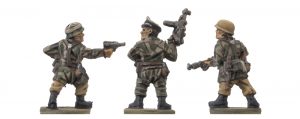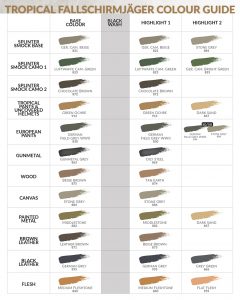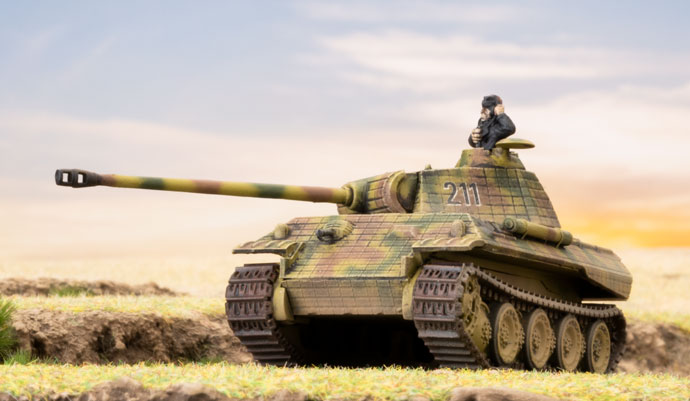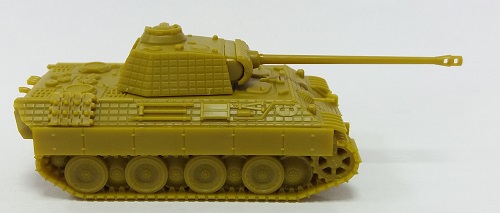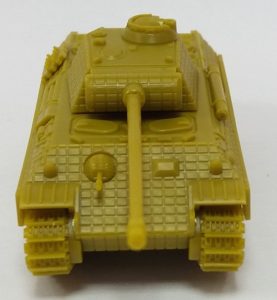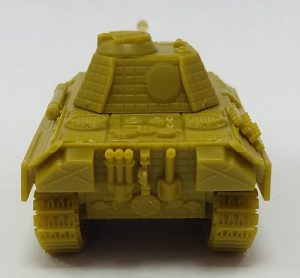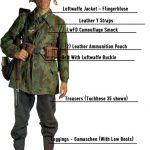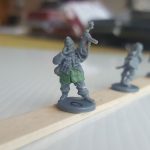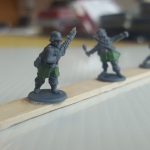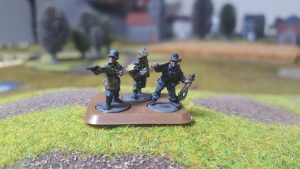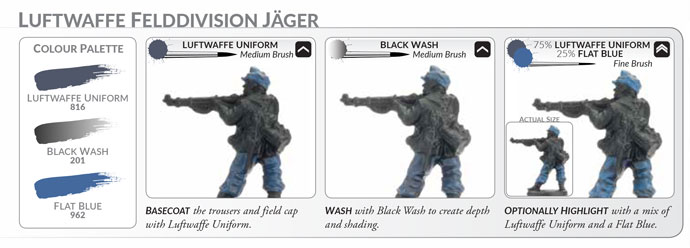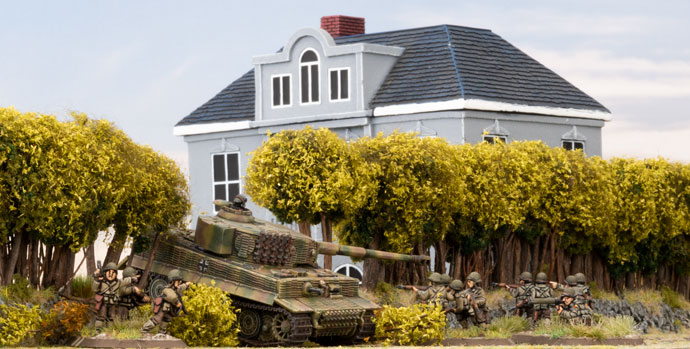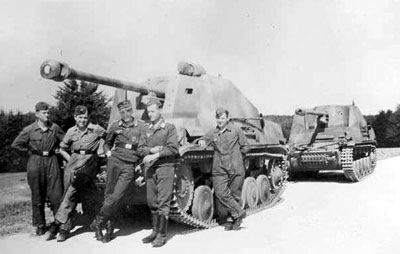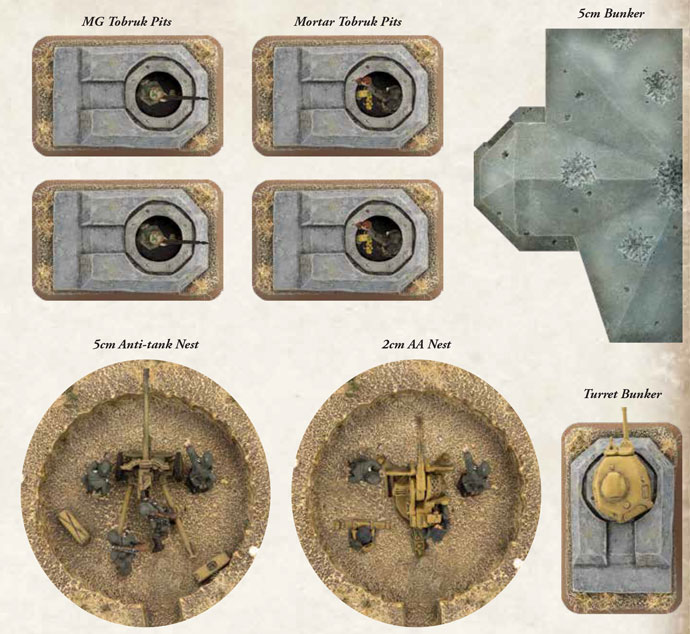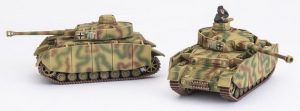Pete the Wargamer shows you how to paint your new German forces from D-Day: German.
Tag: Modelling
D-Day: German Rotations
with Patch
Check out the range of models you can field as part of your D-Day: German force.
Chris Builds a D-Day: German Tournament List
with Chris Potter (Battlefront UK)
Normally when I put together a list, there is an aesthetic or historical reason behind it and I am able to give (at length) reasons why I have chosen that Army. Alas, and much to the relief of my wife, this time is a little different for the German D-Day book. I won’t be waxing lyrical about specific units or
historical formations. Instead I have actually approached the book from a gamer’s point of view, albeit with some restrictions.
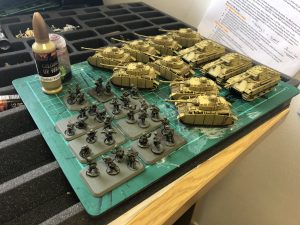
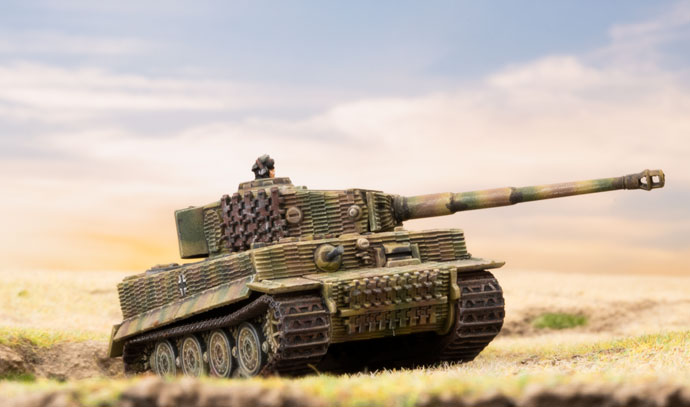
The key difference between this and the Panther G, which most people will know, is the application of Zimmerit on the hull and turret. And the new plastic kit delivers in bucket loads.
Sculpted directly on the plastic is the Zimmerit and it looks seriously good. To round off my force, from a gaming perspective, I needed some troops.
So I add some Panzergrenadiers, sadly bereft of their Halftracks so as to squeeze them into the army at full stand sized companies. Plus by doing this I was able to keep the model count low.
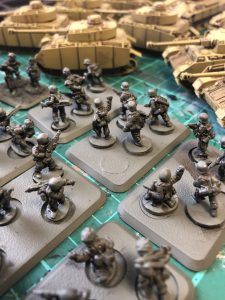

Painting Tropical Fallschirmjäger
with Victor Pesch (Battlefront NZ)
I’m currently starting a new force from D-Day: German, the Fallschirmjäger StuG Assault Gun Company. Instead of having it themed for Normandy, I’m using it to represent Fallschirmjäger & StuGs in the Italian Campaign.
Here’s how I’m painting the new Late-War Plastic Fallschirmjäger figures for my Italy themed platoon in tropical uniforms.
Basecoat
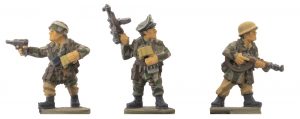
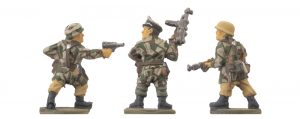
Wash
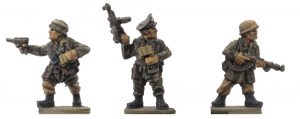
This step is simple as I just cover the entire figure with Black Wash. This darkens everything quite a lot, but I like the way it defines all the elements. It also makes it easy to re highlight with the same base colours without having to find lighter shades.
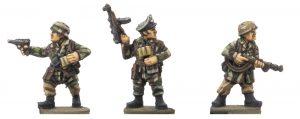
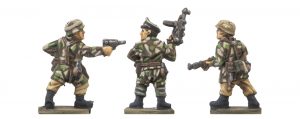
As mentioned above, I generally go back with the base colours and highlight the raised surfaces of everything. Then I sometimes do a second highlight with a different colour on some items.
See below for all the colours I used, but feel free to experiment with your own:
Quick Tip- Worn Leather
A simple way to achieve a worn leather look on straps and bags is to gently dab the edges with a lighter colour. It’s like an edge highlight but the dabbing action gives it a more irregular, worn look.
Now that I’ve figured out my colour choices, I’ve got a lot more figures to paint, and also all the StuGs! I think the platoon will look quite interesting with it’s mix of yellow and field grey pants, and the yellow un covered helmets.
Speaking of uncovered helmets, one last tip: Sponge on some German grey to show the yellow paint chipping off.
The Brand New PLASTIC Panther
with Kai Tun (Battlefront Malaysia)
Check out the Panther in the Online Store…
One of the most exciting kit releases coming with D-Day: German is the Panther A with Zimmerit in all plastic. Here, Kai (BF Malaysia) takes us through a brief overview of the Panther tank and the brand new Panther kit.
The Tank
The Panzer V ‘Panther’ Ausf. A was the second production type of the formidable German medium tank. Many of the reliability issues of the prior Ausf. D, such as engine and transmission problems, were rectified by the time the Panther A faced the Allied invasion in the villages of Normandy.
With a potent 7.5cm KwK 42 L/70 gun and 80mm of sloped frontal armour, it was superior to any individual tank the Americans and British could bring to bear. At the same time, the Panther had superior manoeuvrability compared with the Tiger tank. 2,200 Panther A tanks were built, making it the second-most numerous Panther variant after the Ausf. G. The Panther A saw service on the Eastern Front, as well as in Normandy and Italy, so you’ll
have plenty of opportunities to field – or face – this deadly steel beast.
View from the Factory
The plastic Panther A model has been a long time coming! Needless to say, several members of our Malaysian team were quite happy to be the first hobbyists in the world to build this model.
The new Panther A kit has been designed to use the same track sprue that goes with our older Panther G model. Some of the parts on the track sprue – like the exhaust pipes and the ball-mounted hull MG with Zimmerit – have just been waiting all these years to come together in an all- plastic kit.
Our early assembly tests at the factory helped to ensure that all parts from both old and new sprues fit perfectly. Do note that early Panther A tanks were equipped with a pair of vertical exhaust pipes at the rear of the tank, but later production tanks had a triple pipe coming out of the left side instead of the normal single left pipe, to help with cooling.
This could be a great way to distinguish some Panther A tanks in the Late-War period as newly-arrived replacements! The new hull and turret have been modelled with the Panther A’s Zimmerit anti-mine paste, giving it a very distinctive textured look compared with our Panther G model. Anticipating that Soviet infantry would begin using magnetic anti-tank mines, the Germans began applying the paste to new Panther A tanks in the factory in late 1943 – but ultimately abandoned the practice by September 1944.
D-Day: German Counter List
with Lonnie Mullins (Battlefront US)
The Germans are coming and, not being a German player, I’m planning on beefing up my American D-Day Forces to counter the Panzer IVs, Panthers, and Tigers (oh my) that I hear Brian talking about and expect to be dealing with. I expect to be dealing with somewhere between 9 and 17 tanks so I’ve got to be smart about what I’m taking.
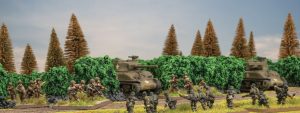
My force consists of 23 Sherman Tanks of various configurations and 2 support vehicles and is broken-down as follows:
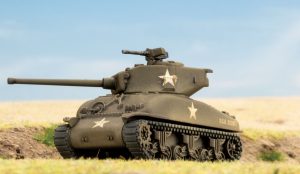
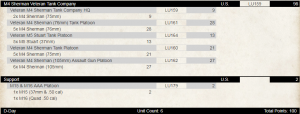
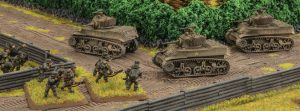
I’ve never used 105mm Sherman Tanks before but I’m eager to get them in the field. The idea of knocking out German Tanks with a Sherman from artillery fire at 48-inches from the top makes me giddy. And their anti-tank for direct fire isn’t too bad either.
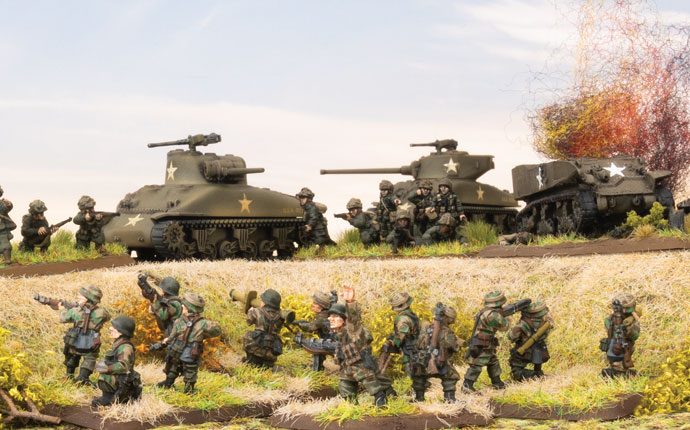
Alex’s Luftwaffe Feld-Division
with Alexander Nebesky (Battlefront NZ)
My first Flames Of War army was German, my Fortress Europe army was German, and when Hobby League started up and everybody had gravitated to the other three forces it seemed like I was destined for Germans again. Luckily for me, with D-Day: German on the horizon I was able to take a deep dive into all the exciting German forces and pick a unique and colourful force to work on.
The key to embarking on any project, Flames Of War or otherwise, is to latch onto something you find interesting. For me, that meant the opportunity to either modify units in my force or paint a colour I haven’t painted before- because after two lots of grenadiers in Field Grey, I was frankly not that interested in doing it a third time around.

Having spent an afternoon spitballing with Phil and Andrew, I came up with a list representing 16. Feld-Division (L) roughly as they were during Operation Goodwood, supported by bits of 21. Panzerdivision.
I’m working out of the very exciting D-Day: German, which isn’t out yet—but then again, what’s the point of hanging out at the Battlefront Studio if I can’t get a little early access. With this in mind, here are my first 50 points: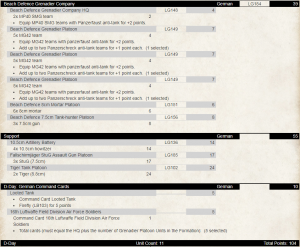
A Brief History of Luftwaffe Field Divisions
The Luftwaffe Field Divisions were raised from the ranks of regular old Luftwaffe ground crew. They weren’t the most exceptional troops on account of having never signed up for infantryman duties, and their inception as dedicated field divisions was more a response to suggestions that the German Army could do with a few hundred thousand more warm bodies than it was the establishment of a military unit full of guys who found their natural calling as foot-sloggers after making a brief detour into air force work (kind of like switching your major at university mid-degree because you found out anthropology was really more your thing than law). In any case, the LwFDs kept their organisation and remained under the leadership of Luftwaffe officers until late in 1943 when they were reorganised and transferred to the Heer.
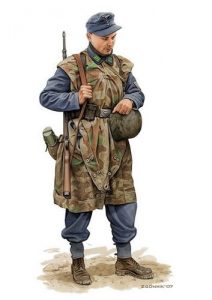
Up until their transfer, Luftwaffe Feld-Division boys were outfitted with the traditional feldblau Luftwaffe Uniform, making them a distinctive blue on the battlefield, quite obviously different to the feldgrau of the Heer. After being subsumed into the army structure, the LwFD boys were outfitted with regular feldgrau Heer uniforms as their original blues ran out. This will give me the opportunity to paint a mixture of Luftwaffe and Heer uniforms and equipment for my force, as by 1944, there would have been a good mix of kit and uniform. A great source for uniforms is this here 18th Luftwaffe Field Division https://18thluftwaffefielddivision.weebly.com/our-kit.html> reenactment group (who don’t appear to have any info on their ‘About Us’ page, so I can’t thank them), and there is a full list of kit I could apply to my LwFD (you can follow the link and see the list yourself) and there is also this handy tidbit on the subject of mixed Heer/Luftwaffe uniforms:
“Very frequently we can see, especially as the war progressed into 1944-45, the use of Heer uniforms and insignia within the ranks of the LwFD. Not only was supply of uniforms and equipment transitioned to Heer supply, but also the replacements of men. It is for these reasons that we find such variance in equipment and uniforms through to the end of the war.”
Smock and Roll
One of the key features of the Luftwaffe field boys was their iconically formless and ubiquitous camouflage smock. The picture at the top of the article shows a man of the Luftwaffe Field Divisions in one of these splinter-camo smocks. The plastic grenadier kit doesn’t happen to be wearing these smocks. If I were playing my LwFD as kitted fully in Heer or fully in Luftwaffe standard service uniforms this would be no problem, I would just paint then feldgrau of feldblau or a mixture of the two and be on my merry way. But no, I’m going to model a selection of my figures in this iconic smock—and that means Green Stuff.
The simple recipe is to trim off the bottom of the uniform jacket, slice off any pockets, and then with a rubber clay brush (as tiny as you can get it) start spreading the green stuff around the waist of the figure and down to just above his knees. The Luftwaffe camo smock did not have any breast pocket, so you could either shave those off the figures or very thinly green stuff around them to hide them, but in most cases there is enough webbing and extra bits of equipment already covering them. The smock did have a pocket on either thigh which you could model with two tiny squares of green stuff.
After priming, I painted the smock according to the instructions in Colours Of War, a mixture of German Camo Beige and Green Ochre, then highlighted with German Camo Beige. To separate my Luftwaffe camo pattern from the Heer I picked a slightly different colour combination, using Vallejo Panzer Aces Splinter Blotches I & II, which give a brighter colour palette and are a good colour choice for FJs too.
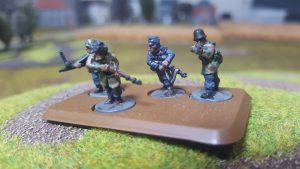
The guys in blue also benefited from Colours of War, as I followed the Luftwaffe Jaeger instruction in the book to get that bright blue I was so looking forward to painting.
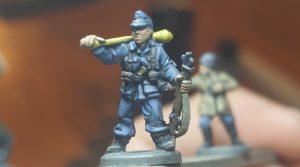
My 50 points of modified Luftwaffe infantry is certainly a bit ambitious, but it’s comforting to know that the following months will see me painting only a handful of tanks, so it’s not the end of the world.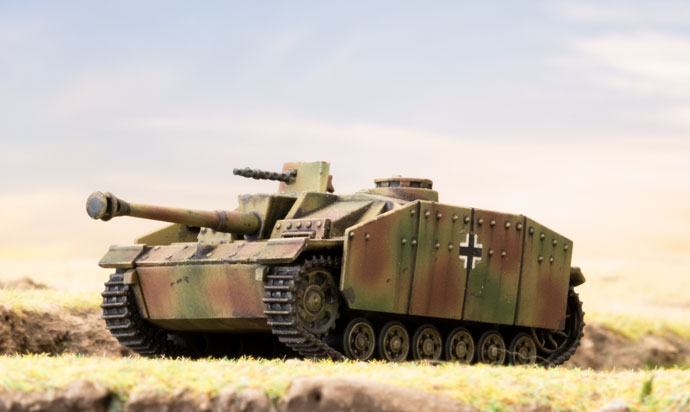
The elements of 21. Panzer that backed up the Luftwaffe in Caen will be represented by a pair of Tiger tanks, a handful of three or four StuGs, and a captured Sherman Firefly. Instead of keeping the list strictly to 100 points, I’m actually painting up a few more points worth of things so I have the option to switch and swap the odd unit or two to give the force a lot more modularity.
Make sure you check back on the Hobby League page each week to see what the gang has been up to, and to see how you can get involved with the Hobby League in your local store or club.
Luftwaffe Field Divisions
with Phil Yates
With the release of D-Day: German comes a series of Command Cards used to represent various specific units from the German defence of Normandy. One such Command Card, Air Force Soldiers, gives players the chance to field 16. Luftwaffe Feld-Division. This card could equally be used to represent many of the Luftwaffe Field Divisions of the war, so we dug up an article from the archives outlining the history of the Luftwaffe Field Divisions- perhaps there’s one here for you to represent on the table with D-Day: German…
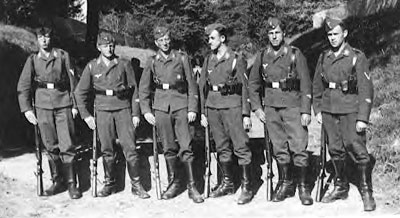
However, Generalmajor Meindl and his staff remained behind and formed Division Meindl from spare Luftwaffe ground crew. Under the veteran Fallschirmjäger commander the division fought well in the defence of Cholm.
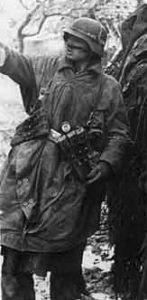
Instead he offered 22 Luftwaffen Felddivisionen, 22 Air Force Field Divisions, that would remain under air force control, although under army command. The success of Meindl’s division swung the balance, and Göring got his way.
The first ten of these divisions were organized in September of 1942, and, still in their air force-blue uniforms, dispatched to the Eastern Front.
Unfortunately, despite their brand new equipment (the envy of army units still fighting with old, worn out gear from previous battles), they had very little infantry training and little heavy support. Unlike Meindl’s division, their officers were airmen with no knowledge of ground combat at all. As a result, the first Luftwaffe field divisions did not perform well when they entered combat. The remaining divisions formed in early 1943 were little better.
At least one half-formed division was overrun by the spearhead of a Soviet attack while marching to the front, still having conducted no training at all! In November 1943, all remaining Luftwaffe field divisions were converted to regular infantry divisions under full army control.
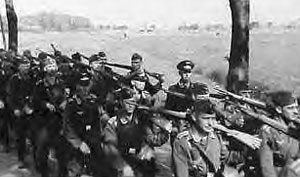
A normal Infanteriedivision had three regiments each of three infantry battalions and an artillery regiment. A Luftwaffe Felddivision had only four Jäger (light infantry) battalions and a single battalion of artillery (often only equipped with out-dated mountain guns or heavy mortars). On top of this, whereas the Infanteriedivision had an anti-tank battalion, a reconnaissance battalion, and a pioneer battalion, the Felddivision often had only one company of each.
The best-equipped divisions had full battalions, but even then, the anti-tank battalion only had 15 anti-tank guns in three companies, one of nine 5cm PaK38, and two each of three 7.5cm PaK40, and no other anti-tank guns in the entire division! There were two positive features though. Firstly, each division had a full Luftwaffe anti-aircraft battalion with four powerful 8.8cm FlaK18 anti-aircraft guns. Secondly, the divisions were entirely equipped with trucks as gun transports and supply vehicles. They had no horses at all.
Divisional Histories
1. Luftwaffe Felddivision (Generalleutnant Gustav Wilke)
Relieved the Spanish 250. Infanterie Division, the famous Blue Division, in November 1942, taking up positions north of Lake Ilmen between Moscow and Leningrad.
This was supposed to be an easy sector, and remained quiet until January 1944 when the Red Army launched a massive attack through the division’s sector, wiping the division out in a matter of days.
The division’s artillery was initially only one battalion of 7.5cm GebK15 mountain guns. It was strengthened by two more battalions in 1943, although the battalions may have only had two batteries of four guns each!

Was formed at the same time as 1. Luftwaffe Felddivision and was similarly equipped. Additionally it had a company of six StuG D assault guns. The division occupied a sector of the Rzhev salient in November 1942. Unusually, its positions were facing west!
On 25 November the southern part of the division was overrun by a massive Red Army attack, although the northern flank held on until 9 December. The division was rescued by 19. Panzerdivision and Grossdeutschland and reoccupied its positions.
The division was attacked again in October 1943 in its new positions near Nevel, abandoning most of its heavy equipment and retreating rather hastily (as the German Army delighted in pointing out to the Luftwaffe). The division continued to fight on until disbanded in January 1944.
3. Luftwaffe Felddivision (Generalleutnant Robert Pistorius)
Formed at the same time as 1. & 2. Luftwaffen Felddivision, this division occupied positions south of Nevel (north of Vitebsk just west of the Rzhev salient). It had a fairly quiet time until Christmas Eve, 1943 when it was attacked by the 5th Tank Corps. The division was quickly cut off and overrun, being disbanded in January 1944.
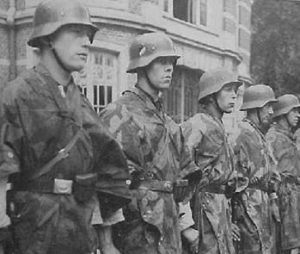
Took up position south of 3. Luftwaffe Felddivision near Nevel. Initially it had one battalion of two batteries of 10.5cm NW40 heavy mortars for its artillery. It gained four more batteries in two more battalions during the summer of 1943. The division was heavily engaged in the battle around Vitebsk, and later absorbed the remnants of the 3. Luftwaffe Felddivision after its disbandment. 4. Luftwaffe Felddivision fought on until it was destroyed in the Vitebsk pocket in June 1944.
5. Luftwaffe Felddivision (Oberst Hans-Bruno Schulz-Heyn)
While the first four divisions fought in the north around Moscow, 5. Luftwaffe Felddivision was sent south to Army Group B in the Caucasus. It was posted to defend Krasnodar, near the Black Sea, with the Rumanian Cavalry Corps. On 11 January 1943 the Red Army launched Operation Mountain to push Army Group B from the Caucasus. The attack split 5. Luftwaffe Felddivision in two. Half remained with the Cavalry Corps, while the other half fought with 4. Gebirgsjägerdivision further north. The fighting continued until May, by which time the division was reunited in the Kuban bridgehead, the only remaining German toehold in the Caucasus. In late May, the division withdrew to Crimea to reorganise before moving to the front lines at Melitopol, just north of the Crimean Peninsula, in September where it absorbed 15. Luftwaffe Felddivision as replacements for previous losses. On 9 October 1943, the Red Army launched another major offensive that cut off the Crimean Peninsula. The division was retreated westward and fought on until disbanded in May 1944.
6. Luftwaffe Felddivision (Generalleutnant Rudolf Peschel)
After defending Velikiye Luki, north of the Rzhev salient, in heavy fighting in November and December 1942, 6. Luftwaffe Felddivision took up position between of 2. & 3. Luftwaffen Felddivisionen near Nevel in July 1943. There it received additional artillery batteries to form weak second and third artillery battalions.
It remained there until the attacks of January 1944.
It fought off heavy attacks with the help of the Hornisse tank-hunters of 519. Panzerjägerabteilung, winning the Knights Cross for the divisional commander and Obergefreiter Heinz Reichmann. It then absorbed the remnants of 2. Luftwaffe Felddivision to replace its losses. The division was destroyed in the Vitebsk pocket in June 1944.
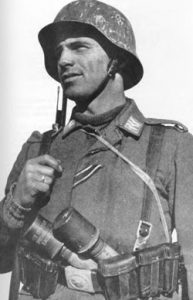
Was hastily rushed to the front to hold the line on the Chir River after the encirclement of Stalingrad. It was involved in continuous fighting until March, 1943 when it was disbanded and the survivors used to strengthen 15. Luftwaffe Felddivision. Oberleutnant Emil Eitel won the Knights Cross during this period.
The division’s artillery was a single battalion of 7.5cm GebK15 mountain guns. They were supported by a company of five StuG D assault guns.
8. Luftwaffe Felddivision (Generalleutnant Wilibald Spang)
Although 8. Luftwaffe Felddivision was supposed to be organised the same as 7. Luftwaffe Felddivision, it was slightly different due to the way it was formed. Kampfgruppe Statel (formed from rear-area Luftwaffe troops retreating from Stalingrad under Oberst Rainer Statel) was already in combat on the Chir River when the rest of the division, newly arrived from Germany, was assigned to a different sector.
While moving up to their assigned positions, the anti-tank battalion and leading battalions ran headlong into the Soviet spearhead and were annihilated. The survivors of the division fought on throughout the winter. In April 1943 what was left of the division was used to strengthen 15. Luftwaffe Felddivision.
9. Luftwaffe Felddivision (Generalmajor Ernst Michael)
The next series of Luftwaffe divisions had a little longer to organise and actually had two regiments of three infantry battalions. In the case of 9. Luftwaffe Felddivision they were 17. & 18. Luftwaffen Jägerregimenter (light infantry regiments). Although the division had no assault guns, it did have two weak battalions of artillery, and in theory, full battalions of anti-tank, pioneers, and infantry reconnaissance.
It joined the divisions guarding the Soviet troops trapped in the Orienbaum pocket on the coast just west of Leningrad in December 1942. It initially occupied an 11-mile front, but this was later increased to 23 miles. Far too long a stretch for such a weak division. One battalion briefly fought with 227. Infanteriedivision around Lake Ladoga, before returning to guard the pocket in March 1943.
The sector was quiet until 14 January 1944, when a massive Soviet attack by the 2nd Shock Army burst through the division. The attack by five infantry divisions and a tank brigade destroyed the Luftwaffe division in just four days.
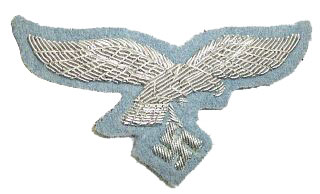
Like 9. Luftwaffe Felddivision, 10. Luftwaffe Felddivision spent most of its life guarding the Orienbaum pocket. In January 1943 a Kampfgruppe or battlegroup from the division fought near Lake Ladoga, supported by four Tiger tanks from 502. schwere Panzerabteilung and Marder tank-hunters of 563 Panzerjägerabteilung.
The same attack that destroyed 9. Luftwaffe Felddivision rolled over the division, although Kampfgruppe Helling fought on until the division was officially disbanded in February 1944. The commander of 19. Luftwaffe Jägerregiment, Oberst Matussek, won the German Cross in Gold for his valiant defence.
Unlike the 9. Luftwaffe Felddivision, the division had three battalions of artillery. One with twelve 10.5cm NW40 heavy mortars, and two battalions of twelve 7.5cm GebK15 mountain guns.
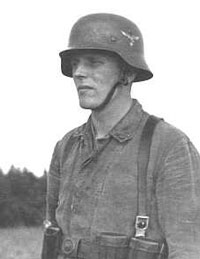
This division was formed in Greece for guard duties and did not see combat until late 1944 as it retreated through the Balkans.
12. Luftwaffe Felddivision (Generalleutnant Herbert Kettner)
One of the two really good Luftwaffe field divisions, 12. Luftwaffe Felddivision was part of Army Group North from February 1943 until the end of the war. It had 23. & 24. Luftwaffen Jägerregimenter, each of three battalions, and two battalions of artillery, each with twelve old 1897-model French 75mm guns. Its anti-tank battalion had twelve new 7.5cm PaK40 anti-tank guns, twelve 2cm FlaK38 anti-aircraft guns, and ten StuG assault guns with long 7.5cm guns.
In February 1943 they entered combat near Lake Ladoga north of 1. Luftwaffe Felddivision. They stopped a Soviet attack in their area winning two German Crosses in Gold in the process. They fought hard and well in the January 1944 fighting and in the subsequent retreats. They were finally cut off in the Courland pocket and ended the war fighting in East Prussia.
13. Luftwaffe Felddivision (Generalmajor Hans Korte)
Entered the line south of 12. Luftwaffe Felddivision in February 1943. It took part in the July 1943 battles, but was destroyed in the retreat in January 1944.
14. Luftwaffe Felddivision
This division spent the war performing garrison duties in Norway.
15. Luftwaffe Felddivision (Generalmajor Eduard Muhr)
This division was scratched together from local air force units around Rostov in November 1942. It absorbed the survivors of 7. & 8. Luftwaffen Felddivisionen in April 1943 and received its artillery regiment from France in May. Its first battles were in July 1943 near Taganarog on the Sea of Azov just west of Rostov. The division was surrounded, but broke out leaving most of its heavy weapons behind. Hauptmann Eitel won a posthumous Knights Cross leading 30. Luftwaffe Jägerregiment through enemy lines.
In October the remnants were at Melitopol on the Dnepr River when they were overrun again. The survivors were absorbed into 5. Luftwaffe Felddivision south of Zaphorye.
16. Luftwaffe Felddivision
Fought in France, 1944 and destroyed at Caen soon after D-Day.
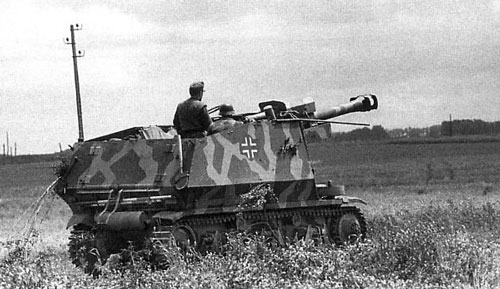
Destroyed defending the Seine crossings in France, 1944, during the breakout from Normandy.
18. Luftwaffe Felddivision
Destroyed in the Mons pocket in France, September 1944.
21. Luftwaffe Felddivision (Generalmajor Richard Schimpf)
21. Luftwaffe Felddivision was formed from Division Meindl, which had five regiments each of four infantry battalions, but little else. Division Meindl was formed as an overall command for the numerous air force security battalions and hastily formed defence battalions that suddenly found themselves in the front lines during the Soviet 1941 winter offensive. When it was formed in February 1942, the regiments were all attached to infantry divisions between Leningrad and Moscow.
1. Luftwaffe Feldregiment was with 218. Infanteriedivision in and around the Cholm pocket.
2. Luftwaffe Feldregiment was with 5. Jägerdivision near Staraya Russia.
3. Luftwaffe Feldregiment was with 12. Infanteriedivision in and around the Demyansk pocket.
4. Luftwaffe Feldregiment was with 18. Infanteriedivision (mot) around Lake Ilmen.
5. Luftwaffe Feldregiment was with 290. Infanteriedivision in and around the Demyansk pocket.
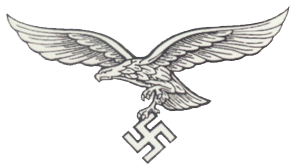
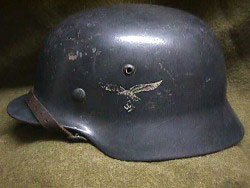
22. Luftwaffe Felddivision
Disbanded before fully formed.
The D-Day: Beach Assault Mission Terrain Pack
If you want to cut to the chase and get to gaming D-Day, you can check out the Mission Terrain Pack in the Online Store…
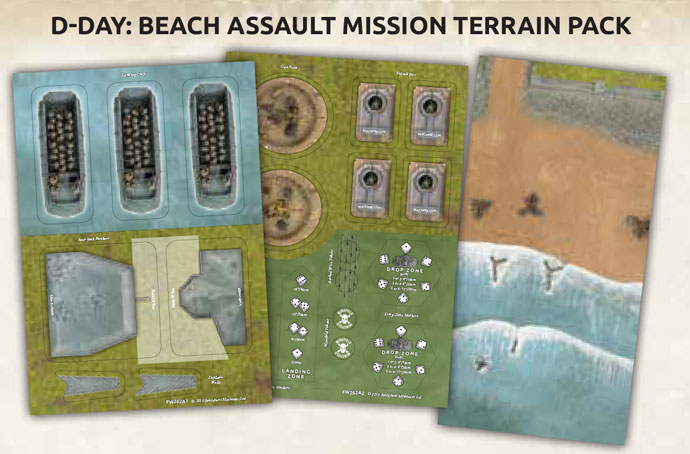
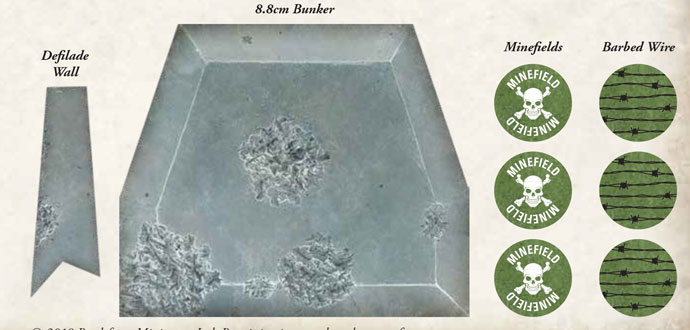
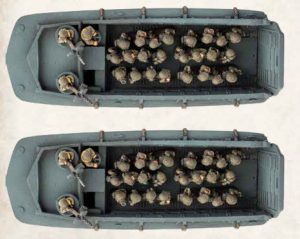
On top of landing craft for beach missions like FUBAR, the Cardboard Terrain mission pack also gives you handy cardboard tokens and pieces for airborne missions. The Drop Zone Marker is used to determine the drift of parachute landing forces, while the Landing Zone Marker is used for troops landing in Gliders.
Wayne’s Big Four Germans
with Wayne Turner (Battlefront NZ)
The Big Four Of Late War is a four-man journey through Late War starting with an army box each and working through every Late War release of V4.

Be sure to regularly check out the Big Four website during the course of the Late War journey- as you can see from the quality of Wayne’s painting here, the Big Four put a lot of effort into presenting exceptional armies.
Follow the Big Four on Instagram here…

